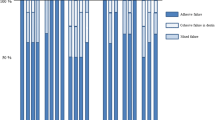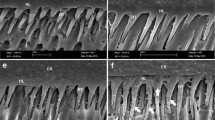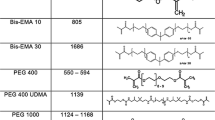Abstract
Objectives
A dental adhesive without small and hydrophilic monomers such as 2-hydroxyethyl methacrylate (HEMA) and triethylene glycol dimethacrylate (TEGDMA) would be beneficial in order to avoid contact allergies. However, these monomers are important to increase infiltration and polymerization of the adhesive. Therefore, the purpose of this study was to evaluate the bonding effectiveness and bond durability of a more hydrophobic and biocompatible adhesive as compared to a conventional three-step etch-and-rinse adhesive.
Methods
Sixteen non-carious human third molars were used to determine the micro-tensile bond strength testing (μTBS) and interfacial ultrastructure by transmission electron microscopy (TEM) of the more hydrophobic cmf adhesive system (Saremco) adhesive as compared to the control OptiBond FL (Kerr).
Results
The more hydrophobic and biocompatible three-step etch-and-rinse adhesive was able to produce a reasonable short-time bonding effectiveness. In the long term, the collagen fibrils in the hybrid layer were not effectively protected and were prone to hydrolytic degradation. As a result, long-term bonding effectiveness of this novel adhesive was very low.
Conclusions
Application of a more hydrophobic adhesive without altering the application procedure considerably results in a reduced durability of the created bond
Clinical relevance
Omitting small and hydrophilic components from the adhesive formulation may impair the durability of your composite restoration.





Similar content being viewed by others

References
Van Landuyt KL, Snauwaert J, De Munck J, Peumans M, Yoshida Y, Poitevin A, Coutinho E, Suzuki K, Lambrechts P, Van Meerbeek B (2007) Systematic review of the chemical composition of contemporary dental adhesives. Biomaterials 28:3757–37585
Nakabayashi N, Watanabe A, Gendusa NJ (1992) Dentin adhesion of "modified" 4-META/MMA-TBB resin: function of HEMA. Dent Mater 8:259–264
Kanerva L, Estlander T, Jolanki R (1994) Occupational skin allergy in the dental profession. Dermatol Clin 12:517–532
Finer Y, Santerre JP (2004) Salivary esterase activity and its association with the biodegradation of dental composites. J Dent Res 83:22–26
Emami N, Söderholm KJ (2009) Young's modulus and degree of conversion of different combination of Light-cure dental resins. Open Dent J 3:202–207
Ye Q, Park JG, Topp E, Wang Y, Misra A, Spencer P (2008) In vitro performance of nano-heterogeneous dentin adhesive. J Dent Res 87:829–833
Zou Y, Armstrong SR, Jessop JL (2010) Quantitative analysis of adhesive resin in the hybrid layer using Raman spectroscopy. J Biomed Mater Res A 94:288–297
Kostoryz EL, Dharmala K, Ye Q, Wang Y, Huber J, Park JG, Snider G, Katz JL, Spencer P (2009) Enzymatic biodegradation of HEMA/bisGMA adhesives formulated with different water content. J Biomed Mater Res B Appl Biomater 88:394–401
Van Meerbeek B, Vargas M, Inoue S, Yoshida Y, Perdigão J, Lambrechts P, Vanherle G (2000) Microscopy investigations. techniques, results, limitations. Am J Dent 13:3D–18D
Mine A, De Munck J, Van Landuyt KL, Poitevin A, Kuboki T, Yoshida Y, Suzuki K, Lambrechts P, Van Meerbeek B (2008) Bonding effectiveness and interfacial characterization of a HEMA/TEGDMA-free three-step etch & rinse adhesive. J Dent 36:767–773
Mine A, De Munck J, Cardoso MV, Van Landuyt KL, Poitevin A, Kuboki T, Yoshida Y, Suzuki K, Van Meerbeek B (2012) Effect of low-shrinking composite on the bonding effectiveness of two adhesives in occlusal Class-I cavities. Dent Mater J 31:418–426
Vaidyanathan TK, Vaidyanathan J (2009) Recent advances in the theory and mechanism of adhesive resin bonding to dentin: a critical review. J Biomed Mater Res B Appl Biomater 88:558–578
Asmussen E, Peutzfeldt A (1998) Influence of UEDMA BisGMA and TEGDMA on selected mechanical properties of experimental resin composites. Dent Mater 14:51–56
Asmussen E, Peutzfeldt A (2001) Influence of selected components on crosslink density in polymer structures. Eur J Oral Sci 109:282–285
Miguez PA, Pereira PN, Foxton RM, Walter R, Nunes MF, Swift EJ Jr (2004) Effects of flowable resin on bond strength and gap formation in Class I restorations. Dent Mater 20:839–845
Santerre JP, Shajii L, Leung BW (2001) Relation of dental composite formulations to their degradation and the release of hydrolyzed polymeric-resin-derived products. Crit Rev Oral Biol Med 12:136–151
Pashley DH, Tay FR, Yiu C, Hashimoto M, Breschi L, Carvalho RM (2004) Collagen degradation by host-derived enzymes during aging. J Dent Res 83:216–221
Hebling J, Pashley DH, Tjäderhane L, Tay FR (2005) Chlorhexidine arrests subclinical degradation of dentin hybrid layers in vivo. J Dent Re 84:741–746
Nishitani Y, Yoshiyama M, Wadgaonkar B, Breschi L, Mannello F, Mazzoni A, Carvalho RM, Tjäderhane L, Tay FR, Pashley DH (2006) Activation of gelatinolytic/collagenolytic activity in dentin by self-etching adhesives. Eur J Oral Sci 114:160–166
De Munck J, Van den Steen PE, Mine A, Van Landuyt KL, Poitevin A, Opdenakker G, Van Meerbeek B (2009) Inhibition of enzymatic degradation of adhesive–dentin interfaces. J Dent Res 88:1101–1106
De Munck J, Van Landuyt K, Peumans M, Poitevin A, Lambrechts P, Braem M, Van Meerbeek B (2005) A critical review of the durability of adhesion to tooth tissue: methods and results. J Dent Res 84:118–132
Yamauti M, Hashimoto M, Sano H, Ohno H, Carvalho RM, Kaga M, Tagami J, Oguchi H, Kubota M (2003) Degradation of resin–dentin bonds using NaOCl storage. Dent Mater 19:399–405
De Munck J, Ermis RB, Koshiro K, Inoue S, Ikeda T, Sano H, Van Landuyt KL, Van Meerbeek B (2007) NaOCl degradation of a HEMA-free all-in-one adhesive bonded to enamel and dentin following two air-blowing techniques. J Dent 35:74–83
Acknowledgements
We thank Ms. Rolande Renwart and Ms. Christiane Armee (Pathology Department, University Hospital of Leuven) for extensive technical assistance. We thank the manufacturers of dental adhesives and composites for their generous donation.
Conflict of interest
The authors declare that they have no conflicts of interest regarding the products herein investigated.
Author information
Authors and Affiliations
Corresponding author
Rights and permissions
About this article
Cite this article
De Munck, J., Mine, A., Vivan Cardoso, M. et al. Hydrolytic stability of three-step etch-and-rinse adhesives in occlusal class-I cavities. Clin Oral Invest 17, 1911–1918 (2013). https://doi.org/10.1007/s00784-012-0884-0
Received:
Accepted:
Published:
Issue Date:
DOI: https://doi.org/10.1007/s00784-012-0884-0



